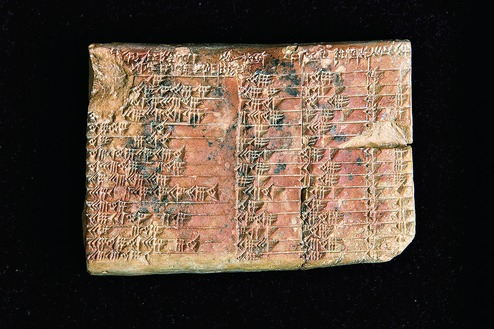
New Delhi, Aug. 24: A 3,700-year-old clay tablet from Babylon is the world's oldest evidence for trigonometry and generates more accurate results in practice than the standard version, two Australian mathematicians said today.
Daniel Mansfield and Norman Wildberger said the numbers inscribed on the tablet, in a table of four columns and 15 rows, represent a kind of trigonometry different from what the world has practised for centuries.
"The ancient Babylonians were the first to do trigonometry - and do it in a way that is completely different from what we've inherited from the Greeks," Mansfield, from the University of New South Wales, told The Telegraph over the phone.
"The trigonometry we practise is based on the angles between the sides of a right-angled triangle; the Babylonian trigonometry was based on the ratios of the sides of the right-angled triangle."
Discovered by US archaeologist Edgar Banks in southern Iraq in the early 1900s and preserved at Columbia University's rare books and manuscripts library, the tablet has long puzzled mathematicians because of its numbers.
The inscription in ancient cuneiform script displays a pattern of numbers called Pythagorean triplets: a series of numbers (3, 4 and 5, for example) in which the sum of the squares of the first two equal the square of the third.
The triplets on the tablet -which has been dated to between 1822 BC and 1762 BC - had stirred speculation that the Babylonians had been familiar with the theorem named after Pythagoras, the sixth-century BC Greek mathematician and philosopher.
But the triplets' connection to triangles - and trigonometry - remained unknown, until now.
In a study published in the journal Historia Mathematica, Mansfield and Wildberger have shown how the 15 rows of numbers on the tablet describe a sequence of 15 right-angled triangles that steadily decrease in inclination.
The Babylonian trigonometry also offers an advantage. Modern trigonometry, based on the ratios of the angles of right-angled triangles, generates irrational numbers (which are unending when written as decimals), forcing engineers to introduce approximations into their calculations.
"But Babylonian trigonometry is based on the ratios of the sides of the triangles, which are exact numbers," Mansfield said. "There are no approximations whatsoever. This is a rare instance of the ancient world teaching us something new."
The researchers speculate that ancient Babylonians may have used this version of trigonometry to help build palaces and other structures in their cities. "We know this is a trigonometric table but how exactly they used it, what purpose it had, remains unclear," Mansfield said.
An Indian astronomer familiar with ancient science said the finding was exciting but not surprising because the Babylonians had long been known to have had a culture of documentation and mathematics.
"They explored astronomy and mathematics with gusto, and this new finding is just one more aspect of their mathematical powers," said Mayank Vahia, senior astronomer at the Tata Institute of Fundamental Research, Mumbai, who was not associated with the Australian study.
Historians of mathematics have long viewed the Greek astronomer Hipparchus (190-120 BC) as the founder of trigonometry but the Babylonian tablet predates him by more than 1,000 years, Wildberger said in a media release.
Vahia said that any culture that builds square houses requires some knowledge of trigonometry. Most cultures, he added, were familiar with the Pythagorean triplets long before Pythagoras.
"The genius of Pythagoras lay in proving that for a right-angled triangle, the sum of the squares of two sides is equal to the square of the third."










